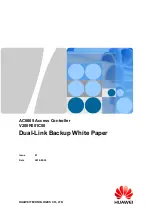
AC6605 Access Controller
Dual-Link Backup White Paper
1
Dual-Link Backup
Issue 01 (2012-05-30)
Huawei Proprietary and Confidential
Copyright © Huawei Technologies Co., Ltd.
2
1.2 Availability
Version Support
Product
Product Version
AC6605
V200R001C00
Constraints
Dual-link backup has the following constraints:
The active and standby ACs must have the same WLAN service configuration.
APs must be able to communicate with both the active and standby ACs. When APs
communicate with the ACs through a Layer 2 network, APs must belong to the same
VLAN as the ACs, and AP IP addresses must be on the same network segment as AC IP
addresses.
If the active AC functions as a DHCP server to allocate IP addresses to APs, configure
static IP addresses for APs or configure an IP address pool only on the active AC. If you
need to configure IP address pools on both ACs, ensure that the IP address pools on the
two ACs do not overlap. Otherwise, IP address conflicts may occur.
The ACs cannot allocate IP addresses to STAs or work as gateways for STAs.
1.3 Principles
1.3.1 Dual-Link Backup Mechanism
Dual-link backup is enabled on active and standby ACs so that APs can establish Control and
Provisioning of Wireless Access Points (CAPWAP) tunnels with both ACs. The status of an
AP is displayed as normal on the active AC and displayed as standby on the standby AC.
When both the active and standby ACs are working properly, only the active AC manages
services of APs and delivers configurations to the APs.
An AP sends Echo packets to monitor the status of the links connected to the ACs. When the
active AC is unavailable because of an AC fault or network failure, an AP detects that the link
connected to the active AC is Down, and the AP status on the standby AC changes from
standby to normal. The standby AC then delivers configurations to the AP and manages
services of the AP.
When the AP detects that the link connected to the active AC recovers, it switches service
traffic back to the active AC within 500 seconds if revertive switching is enabled. After the
switchover, the AP status is displayed as normal on the active AC and displayed as standby on
the standby AC. If revertive switching is disabled, the AP still sends service traffic to the
standby AC.
As shown in Figure 1-1, the APs set up CAPWAP tunnels with the active AC (AC1) and
standby AC (AC2) simultaneously when they go online. The APs and ACs exchange
handshake packets to monitor the link status. When the APs detect that the links connected to
AC1 fail, they switch service traffic to AC2. As they have established CAPWAP tunnels with
AC2, service switching time is reduced. However, users need to go online again after the








































